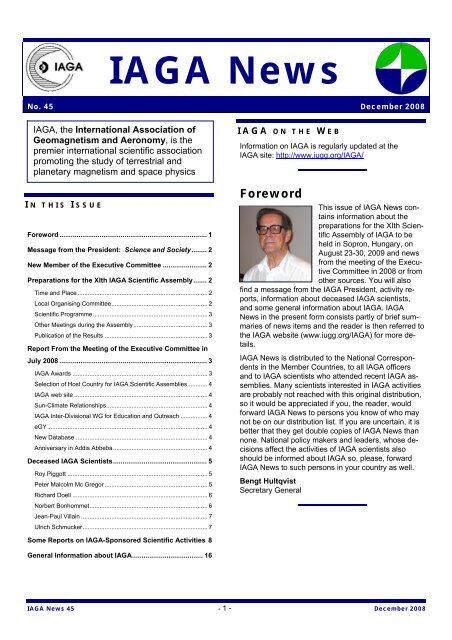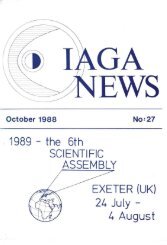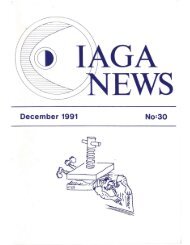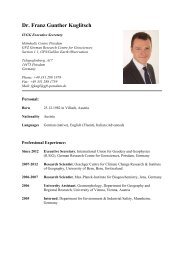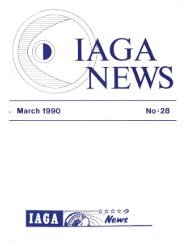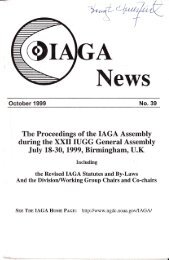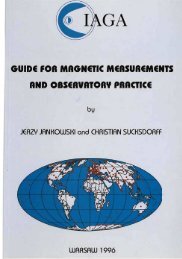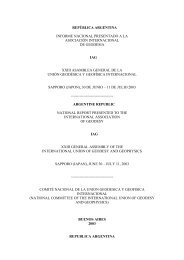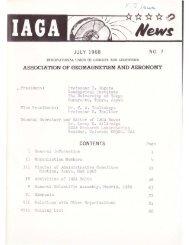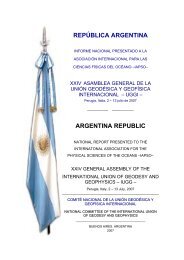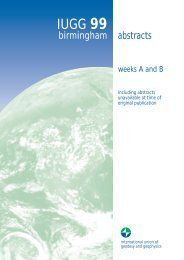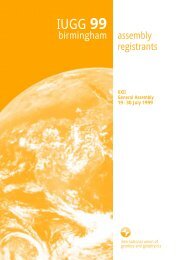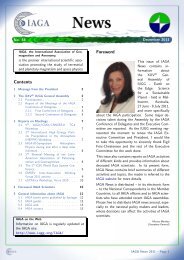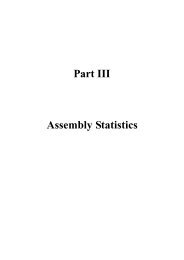IAGA News 45 - IUGG
IAGA News 45 - IUGG
IAGA News 45 - IUGG
You also want an ePaper? Increase the reach of your titles
YUMPU automatically turns print PDFs into web optimized ePapers that Google loves.
<strong>IAGA</strong> <strong>News</strong><br />
No. <strong>45</strong> December 2008<br />
<strong>IAGA</strong>, the International Association of<br />
Geomagnetism and Aeronomy, is the<br />
premier international scientific association<br />
promoting the study of terrestrial and<br />
planetary magnetism and space physics<br />
I N THIS I SSUE<br />
Foreword............................................................................. 1<br />
Message from the President: Science and Society........ 2<br />
New Member of the Executive Committee ....................... 2<br />
Preparations for the XIth <strong>IAGA</strong> Scientific Assembly....... 2<br />
Time and Place ............................................................................. 2<br />
Local Organising Committee......................................................... 2<br />
Scientific Programme.................................................................... 3<br />
Other Meetings during the Assembly............................................ 3<br />
Publication of the Results ............................................................. 3<br />
Report From the Meeting of the Executive Committee in<br />
July 2008 ............................................................................. 3<br />
<strong>IAGA</strong> Awards ................................................................................ 3<br />
Selection of Host Country for <strong>IAGA</strong> Scientific Assemblies............ 4<br />
<strong>IAGA</strong> web site ............................................................................... 4<br />
Sun-Climate Relationships............................................................ 4<br />
<strong>IAGA</strong> Inter-Divisional WG for Education and Outreach ................ 4<br />
eGY............................................................................................... 4<br />
New Database .............................................................................. 4<br />
Anniversary in Addis Abbeba........................................................ 4<br />
Deceased <strong>IAGA</strong> Scientists................................................. 5<br />
Roy Piggott ................................................................................... 5<br />
Peter Malcolm Mc Gregor ............................................................. 5<br />
Richard Doell ................................................................................ 6<br />
Norbert Bonhommet...................................................................... 6<br />
Jean-Paul Villain ........................................................................... 7<br />
Ulrich Schmucker.......................................................................... 7<br />
Some Reports on <strong>IAGA</strong>-Sponsored Scientific Activities 8<br />
General Information about <strong>IAGA</strong>..................................... 16<br />
<strong>IAGA</strong> ON THE W EB<br />
Information on <strong>IAGA</strong> is regularly updated at the<br />
<strong>IAGA</strong> site: http://www.iugg.org/<strong>IAGA</strong>/<br />
Foreword<br />
This issue of <strong>IAGA</strong> <strong>News</strong> contains<br />
information about the<br />
preparations for the XIth Scientific<br />
Assembly of <strong>IAGA</strong> to be<br />
held in Sopron, Hungary, on<br />
August 23-30, 2009 and news<br />
from the meeting of the Executive<br />
Committee in 2008 or from<br />
other sources. You will also<br />
find a message from the <strong>IAGA</strong> President, activity reports,<br />
information about deceased <strong>IAGA</strong> scientists,<br />
and some general information about <strong>IAGA</strong>. <strong>IAGA</strong><br />
<strong>News</strong> in the present form consists partly of brief summaries<br />
of news items and the reader is then referred to<br />
the <strong>IAGA</strong> website (www.iugg.org/<strong>IAGA</strong>) for more details.<br />
<strong>IAGA</strong> <strong>News</strong> is distributed to the National Correspondents<br />
in the Member Countries, to all <strong>IAGA</strong> officers<br />
and to <strong>IAGA</strong> scientists who attended recent <strong>IAGA</strong> assemblies.<br />
Many scientists interested in <strong>IAGA</strong> activities<br />
are probably not reached with this original distribution,<br />
so it would be appreciated if you, the reader, would<br />
forward <strong>IAGA</strong> <strong>News</strong> to persons you know of who may<br />
not be on our distribution list. If you are uncertain, it is<br />
better that they get double copies of <strong>IAGA</strong> <strong>News</strong> than<br />
none. National policy makers and leaders, whose decisions<br />
affect the activities of <strong>IAGA</strong> scientists also<br />
should be informed about <strong>IAGA</strong> so, please, forward<br />
<strong>IAGA</strong> <strong>News</strong> to such persons in your country as well.<br />
Bengt Hultqvist<br />
Secretary General<br />
<strong>IAGA</strong> <strong>News</strong> <strong>45</strong> - 1 - December 2008
Message from the<br />
President:<br />
Science and Society<br />
I was tempted to call this<br />
message “Science for Society”<br />
in line with the current<br />
trend within various science<br />
communities to demonstrate<br />
the benefit to society of their<br />
specific disciplines. But immediately<br />
I realised that this<br />
phrasing is marked with a<br />
definition of science as just<br />
providing solutions to the<br />
problems identified by society. Science certainly has<br />
that aspect also, but science is much more. In particular<br />
science is about an open exchange of views and<br />
ideas not impeded by politics. History has demonstrated<br />
that advancement of science is intimately connected<br />
to a continual dialog between competing views<br />
based on experimental and/or observational facts.<br />
During the last year climate science has become an<br />
increasingly hotter topic in the public debate and<br />
among politicians. Awarding Al Gore and the Intergovernmental<br />
Panel on Climate Change (IPCC) the Nobel<br />
Prize a year ago obviously had a big impact in the<br />
public. Although not a science prize, in the media it<br />
was generally regarded as the final acceptance of the<br />
climate model projections of future climate. The debate<br />
is over; it was said over and over again.<br />
What is meant but not always clearly expressed is that<br />
the political debate is over. With the current uncertainty<br />
and the future risks expressed by the climate community<br />
the politicians decided they had sufficient information<br />
to act. In particular because actions in form of a<br />
major push of research into new technologies for<br />
power generation, energy storage and transportation is<br />
a rational and beneficial policy, regardless of any climate<br />
projection.<br />
However, as scientists, we should be the last to confuse<br />
politics and science. As long as we see the advancement<br />
of science, the scientific debate will and<br />
must continue. The Earth’s climate is a complex physical<br />
system involving a number of different scientific<br />
disciplines, spatial regimes, and feed-back mechanisms<br />
including the oceans, land vegetation, the atmosphere,<br />
and the cryosphere. And possibly also the<br />
upper atmosphere and even particles from space play<br />
an important role.<br />
To understand such a complex system we need to rely<br />
on complicated physical and mathematical models like<br />
the General Circulation Models (GCMs). But we must<br />
never forget that models cannot possibly include Nature’s<br />
entire plethora of physical processes. And we<br />
must never forget that only experiments and observa-<br />
tions can provide the means to decide, which models<br />
are right and which models are insufficient.<br />
This is exactly what our science is all about.<br />
Best wishes to everyone for 2009.<br />
Eigil Friis-Christensen<br />
President<br />
New Member of the<br />
Executive Committee<br />
In November 2007 Vladimir Papitashvili had to resign<br />
from his membership in the Executive Committee of<br />
<strong>IAGA</strong> as a consequence of having accepted a permanent<br />
position as a Program Director in the U.S. National<br />
Science Foundation, which might lead to conflicts<br />
of interests.<br />
The Executive Committee appointed in his stead<br />
Daniel Baker, Director of the Laboratory for Atmospheric<br />
and Space Physics at the University of<br />
Colorado, USA, as a member of the Committee up to<br />
the next election in 2011.<br />
Preparations for the XIth<br />
<strong>IAGA</strong> Scientific Assembly<br />
Time and Place<br />
The XIth Scientific Assembly will take place in the old<br />
university town Sopron in westernmost Hungary between<br />
August 23 and 30, 2009. The scientific sessions<br />
will be held on Monday to Saturday, August 24-29.<br />
Registration and all lecture and poster halls are situated<br />
within five minutes by foot from each other in the<br />
western part of the beautiful horseshoe-shaped old<br />
town, which is also downtown of Sopron and “Sopron<br />
Downtown Convention District”. Headquarters, with<br />
registration, opening and closing ceremonies, Association<br />
lectures and part of the sessions, will be in the<br />
Liszt Ferenc Conference and Culture Centre.<br />
Local Organising Committee<br />
The Local Organising Committee (LOC) is chaired by<br />
László Szarka, Director of the geophysical section of<br />
the Geodetic and Geophysical Research Institute of<br />
the Hungarian Academy of Sciences in Sopron. Technical<br />
organiser is Attila Varga of the Diamond Congress<br />
Ltd. In Budapest. There are three co-chairs:<br />
Gabriella Sátori, Viktor Vesztergom and Bertalan<br />
Zieger. Márta Toth is treasurer. Further members are:<br />
József Bór, Géza Erdös, Tilda Fleishhacker, Gábor<br />
<strong>IAGA</strong> <strong>News</strong> <strong>45</strong> - 2 - December 2008
Hatos, Balázs Heilig, Károly Kis, Árpad Kis, János<br />
Kiss, András Koppán, Károly Kecskeméty, Károly<br />
Kovács, Alpár Körmendi, István Lemperger, Janós<br />
Lichtenberger, András Ludmány, Dániel Martini, Emö<br />
Márton, Tamás Nagy, Attila Novak, Timea Prodán,<br />
Sándor Puszta, Krisztina Rokob, Sándor Szalai, Judit<br />
Szendröi, Mariella Tátrallyay, and Zoltán Vörös.<br />
There is also an Advisory Committee consisting of<br />
Hungarian scientists.<br />
The address to LOC is: <strong>IAGA</strong> 2009 LOC (MTA GGKI),<br />
H-9400 Sopron, Csatkai u. Hungary (H-9401 Sopron,<br />
POB 5, Hungary).<br />
Tel +3699 508340; Fax +3699508355<br />
e-mail<br />
loc@iaga2009sopron.hu<br />
website<br />
www.iaga2009sopron.hu<br />
Scientific Programme<br />
The scientific programme contains 56 symposia covering<br />
all parts of the <strong>IAGA</strong> sciences. Descriptions of<br />
the symposia and information about abstract submission,<br />
registration, visa and many other things can be<br />
found in the Second Circular from LOC at the above<br />
web site for <strong>IAGA</strong> 2009. There will be oral sessions<br />
between 0830 and 1200 and between 1330 and 1700.<br />
Poster sessions will be between 1700 and 1900.<br />
Two Association Lectures, for all participants, will be<br />
given in the mornings of Wednesday and Thursday on<br />
– Magnetic Anomalies– and –The Mesosphere as a<br />
Link in Sun-Climate Relationships– respectively.<br />
Other Meetings during the Assembly<br />
The Conference of Delegates will meet on Monday<br />
and Friday and the Executive Committee will meet four<br />
times during the week.<br />
All Working Groups and the Divisions and Commissions<br />
will hold their business meetings during the week<br />
of the Assembly. Because of the few days available,<br />
most working group business meetings will take place<br />
during lunch breaks and the participants in the lunch<br />
business meetings will be provided with free sandwich<br />
lunches. Another result of the short time available is<br />
that opening and closing ceremonies will take place in<br />
the evening, at 1900 on Monday and Saturday,<br />
respectively. On Monday at 2000 there will be a<br />
welcome reception and on Thursday evening a<br />
banquet.<br />
Publication of the Results<br />
The Springer publishing company has proposed to<br />
publish five books covering the outcome from the fields<br />
of the five Divisions at the <strong>IAGA</strong> 2009 Scientific Assembly.<br />
The Executive Committee has decided to negotiate<br />
an agreement with Springer about such a publication<br />
project. The books will not be just proceedings<br />
of the invited and contributed papers but they will<br />
contain a selection of papers presented and summaries<br />
of the majority of papers written specially for tha<br />
books. The head-editors, who will be responsible for<br />
the planning and production of the five books, will be:<br />
for Division I: E. Petrovsky and T. Harinarayana<br />
for Division II: M. Abdu and D. Pancheva<br />
for Division III: W. Liu and M. Fujimoto<br />
for Division IV: M. P. Miralles and J. S. Almeida<br />
for Division V: M. Mandea and M. Korte<br />
Report From the Meeting of<br />
the Executive Committee in<br />
July 2008<br />
<strong>IAGA</strong> Awards<br />
Besides the most distinguished <strong>IAGA</strong> award,<br />
Honorary Member of <strong>IAGA</strong>, which is decided by the<br />
Conference of Delegates, the Executive Committee of<br />
<strong>IAGA</strong> at present can give out two kinds of awards, The<br />
Long-Term Distinguished Service Medal, which is<br />
intended for persons who are not in a scientific career<br />
but have served <strong>IAGA</strong> sciences in technical or managerial<br />
positions, such as operators of magnetic or other<br />
geophysical observatories, and Young Scientists<br />
Presentation Award, which is presented to young<br />
scientists (below 30) who have given an outstanding<br />
presentation at an <strong>IAGA</strong>-sponsored topical meeting of<br />
a paper where they are the first author about a research<br />
project in which they have plaid a major role. It<br />
consists of economic support for attending the next<br />
<strong>IAGA</strong> assembly.<br />
The Executive Committee has for some time considered<br />
the establishing of a new medal for scientific service<br />
to <strong>IAGA</strong>. At this meeting the EC, however, decided<br />
to give up these plans because of the problems<br />
foreseen in selecting the right awardees among the<br />
large number of prominent <strong>IAGA</strong> scientists. Instead the<br />
EC decided to consider an award for interdisciplinary<br />
work.<br />
<strong>IAGA</strong> <strong>News</strong> <strong>45</strong> - 3 - December 2008
Selection of Host Country for <strong>IAGA</strong><br />
Scientific Assemblies<br />
Because of the experience of the problems to uphold<br />
the policy to hold about every second scientific assembly<br />
in developing countries and the general unpredictability<br />
of the outcome of the voting by the Conference<br />
of Delegates, it was agreed to change the way<br />
the location of <strong>IAGA</strong> scientific assemblies is decided in<br />
such a way that only one location is presented to the<br />
Conference of Delegates, closely following the procedure<br />
<strong>IUGG</strong> has recently decided for the <strong>IUGG</strong> General<br />
Assemblies.<br />
<strong>IAGA</strong> web site<br />
The President and the National Space Institute of the<br />
Technical University of Denmark are taking over as<br />
custodian of the <strong>IAGA</strong> web site. A first version of the<br />
new web site is up for discussion and improvement.<br />
The President will look after the content and the<br />
maintenance.<br />
Sun-Climate Relationships<br />
The Executive Committee concluded after a discussion<br />
that <strong>IAGA</strong> is the proper international organization for<br />
handling the subject Sun-climate relationships. A<br />
committee of independent scientists will be set up to<br />
evaluate the present knowledge of Sun-climate relations.<br />
It was also concluded that it is important for the<br />
future of <strong>IAGA</strong> to be visible on societal matters like the<br />
one of Sun-climate relationships.<br />
<strong>IAGA</strong> Inter-Divisional WG for<br />
Education and Outreach<br />
The first Chair of the IDWG EO, Emily CoBabe-<br />
Ammann in Boulder, has asked to be replaced as chair<br />
of the working group. Larry Newitt in Ottawa has accepted.to<br />
be the new Chair.<br />
Eduard Petrovsky and Charlie Barton have agreed to<br />
assist the ICWG EO in contacting organizers of <strong>IAGA</strong>sponsored<br />
topical meetings about outreach activities in<br />
connection with the meetings.<br />
eGY<br />
The Executikve Committee of the International Union<br />
of Geodesy and Geophysics (<strong>IUGG</strong>) decided at a<br />
meeting in August 2008 to establish a Union Commission<br />
on Data and Information (UCDI) which will continue<br />
and develop at union level the activities which<br />
have been conducted by eGY, initiated by <strong>IAGA</strong> in<br />
Sapporo in 2003.<br />
At the meeting in July 2008 the <strong>IAGA</strong> Executive Committee<br />
concluded that <strong>IAGA</strong> has done well by starting<br />
eGY and is well located for keeping an important role<br />
as the international work on data management is continued<br />
within <strong>IUGG</strong>, ICSU and otherwise.The positive<br />
development hitherto is due to efforts of many people<br />
but primarily those of Charlie Barton, Peter Fox and<br />
Bill Peterson. <strong>IAGA</strong> should try to keep a lead in this<br />
field.<br />
New Database<br />
A new database for paleointensity data has been established<br />
recently. It is named PINT08. Its characteristics<br />
and ways of reaching are as follows:<br />
• Contains all published absolute palaeointensity<br />
data with ages older than 50 ka (3,360 sitemean<br />
measurements).<br />
• Newly updated with 681 data published in period<br />
2003 – 2008 by Lisa Tauxe and Andy Biggin.<br />
• Available for download as MS Excel file from<br />
Andy Biggin’s homepage:<br />
http://www.geo.uu.nl/~forth/people/Andy/Andy.htm<br />
• Data with ages younger than 50 ka now in<br />
GEOMAGIA50 database:<br />
http://data.geophysics.helsinki.fi/archeo/<br />
• All data in process of being uploaded to the<br />
MagIC database http://www.earthref.org/MAGIC/ so<br />
that there will be simultaneous data repositories.<br />
Anniversary in Addis Abbeba<br />
An International Scientific Conference to mark the 50th<br />
Anniversary of the Founding of the Geophysical Observatory<br />
of Addis Ababa University was held in Addis<br />
Ababa, 1-2 November 2007. The Observatory now has<br />
geomagnetism, seismology and GPS instruments, and<br />
the IGS permanent GPS station was inaugurated during<br />
the meeting. Out of 30 oral presentations, a good<br />
number were given by international participants,<br />
mainly from Europe and North America, but also from<br />
elsewhere in Africa and Australia. The theme of the<br />
technical sessions of the conference was the Geodynamics<br />
of Afar and the Ethiopian rifts: Geophysics,<br />
Geohazard Challenges and Resources, and the keynote<br />
address was given by the Minister for Mines and<br />
Energy. There were some presentations not directly<br />
related to the conference theme, especially those<br />
concerned with the geomagnetic observatory activity.<br />
Prof Paul Mohr was due to speak about the early years<br />
of the Observatory, and Prof Pierre Gouin S.J., foun-<br />
<strong>IAGA</strong> <strong>News</strong> <strong>45</strong> - 4 - December 2008
der and first director, but had to return to Ireland for<br />
family reasons. However, Ms Frances Williams gave<br />
his presentation and also shared her reminiscences of<br />
working with Prof Gouin. Dr Arnaud Chulliat spoke<br />
about the Addis Ababa INTERMAGNET magnetic observatory,<br />
and Prof Kathy Whaler about the contribution<br />
of the Addis Ababa geophysical observatory to<br />
geomagnetism. Following the conference, there was a<br />
very enjoyable 2 day field trip into the Ethiopian rift,<br />
including an overnight stay at the hot springs of<br />
Sodore.<br />
Deceased <strong>IAGA</strong> Scientists<br />
Roy Piggott<br />
It is with great sadness that we announce the death in<br />
Cambridge on Tuesday 20 May of Roy Piggott at the<br />
age of 93. Piggott, as he was known to most of his<br />
colleagues, made many and varied contributions to<br />
ionospherics physics. He started as an assistant to Sir<br />
Edward Appleton in the 1930s and did much original<br />
radio physics research during the Second World War.<br />
In the immediate post-war era, he played a major role<br />
in establishing the German ionospheric research at<br />
Lindau, and for this clandestine operation he was<br />
awarded the Order of the British Empire.<br />
Perhaps Piggott will be best remembered for writing,<br />
with Karl Rawer, the definitive handbook on the interpretation<br />
of ionograms, and for his leadership in Antarctic<br />
ionospheric research. Piggott was the prime<br />
mover in establishing the ionospheric observatory at<br />
Halley Bay in the International Geophysical Year,<br />
(1957-1958) and provided oversight of the programme<br />
for the next two decades. Latterly he was Head of Atmospheric<br />
Sciences at the British Antarctic Survey.<br />
Piggott was unfailingly generous with his time, scientific<br />
insight and ideas. He will be remembered by his<br />
many friends and colleagues on every continent for his<br />
kindness, patience and skill as a mentor and advisor.<br />
Everybody whose lives have been touched by Piggott<br />
has their own particular story about this lovable archetypal<br />
British eccentric. He was universally highly<br />
respected, and will be sorely missed by colleagues<br />
around the world. Piggott will live on through his humanity<br />
and his legacy to ionospheric physics.<br />
Alan Rodger<br />
Peter Malcolm Mc Gregor<br />
Australian geophysicist, Peter Malcolm McGregor,<br />
passed away on 18 March 2008, aged 79, from the<br />
secondary effects of cancer. He had been active in<br />
observatory geophysics, particularly in geomagnetism<br />
and seismology, throughout his career.<br />
Peter’s first job on graduating from the University of<br />
Western Australia in the late 1940s was at the remote<br />
Watheroo observatory in southwest Western Australia.<br />
Originally established in 1919 by the Carnegie Institution<br />
of Washington, in July 1947 the observatory was<br />
transferred to the Australian Bureau of Mineral Resources<br />
(BMR) and had a program of geomagnetic,<br />
geoelectric, ionospheric, atmospheric and solar observations.<br />
By 1958 Peter had become its Observer in<br />
Charge.<br />
He was later instrumental in moving observatory operations<br />
from their remote Watheroo site to a new site<br />
on the outskirts of Perth. The new Mundaring Geophysical<br />
Observatory was commissioned in 1959 with<br />
Peter its inaugural OIC. Its program consisted of<br />
geomagnetic, seismological, and ionospheric observations.<br />
In 1968 Peter and his young family moved across the<br />
country to Canberra where Peter took charge of the<br />
BMR’s observatory program, which at that time comprised<br />
observatories at Gnangara (Western Australia),<br />
Toolangi (Victoria), Port Moresby (Papua New<br />
Guinea), Macquarie Island and Mawson (Antarctica).<br />
Under Peter’s care, over the ensuing 20 years this<br />
network grew and its technology changed from photographic<br />
recording to digital data acquisition. Today the<br />
Australian geomagnetic observatory network consists<br />
of 9 observatories – 6 in Australia and 3 in Antarctica.<br />
Between 1977 and 1986, Peter represented Australia<br />
with distinction on the UN Group of Scientific Experts<br />
which devised an international verification system for<br />
the UN Comprehensive Nuclear-Test-Ban Treaty. This<br />
treaty was adopted in 1996 and is an important deterrent<br />
to the proliferation of nuclear weapons.<br />
Peter was instrumental in establishing Australia’s observatory<br />
program in the Antarctic. He wintered at<br />
Macquarie Island in 1952 and Mawson in 1956. At<br />
Macquarie Island, geomagnetic measurements had<br />
been made sporadically since Sir Douglas Mawson’s<br />
1911 Australasian Antarctic Expedition. Peter established<br />
regular observatory operations there in April<br />
1952. At Mawson, geomagnetic field recording had<br />
begun in 1955 using buildings relocated from the magnetic<br />
observatory at Atlas Cove on Heard Island. Macquarie<br />
Island and Mawson are today the longest serving<br />
Australian geomagnetic observatories.<br />
Peter was a talented Australian Rules footballer in his<br />
younger years, a sport he took up at high school. His<br />
enthusiasm for the game remained with him throughout<br />
his life. He also loved the adventure of travel to<br />
out of the way places, whether through the forests of<br />
southwest Western Australia on his Indian motorbike in<br />
the 1940s, on remote fieldwork in the Antarctic, or to<br />
historic outback Australian pubs off the beaten track in<br />
his trusty 4-wheel-drive after his retirement.<br />
<strong>IAGA</strong> <strong>News</strong> <strong>45</strong> - 5 - December 2008
Peter was a passionate scientist, a dedicated family<br />
man, great company in an Antarctic blizzard, keen<br />
sportsman, and connoisseur of fine beer. He has left<br />
an enduring legacy for Australian and international observatory<br />
geophysics.<br />
Adrian Hitchman<br />
Richard Doell<br />
Richard Doell, a distinguished USGS scientist (retired),<br />
died in his sleep on March 6, 2008, at his home in<br />
Point Richmond, California, following a series of grave<br />
illnesses.<br />
Born in Oakland in 1923, Richard grew up in Carpinteria,<br />
California. After serving for 2 years as a combat<br />
infantryman during World War II, he resumed his<br />
studies at UC Berkeley, where he earned his doctorate<br />
in geophysics in 1955. Following graduation Richard<br />
held teaching positionsat the University of Toronto and<br />
MIT. Richard joined the USGS Geophysics Branch in<br />
Menlo Park, California in 1959 where he specialized in<br />
research on the earth’s magnetic field and remnant<br />
magnetism in rocks. He was an integral member of a<br />
team that presented convincing evidence of periodic<br />
polarity reversals of earth’s main magnetic field by<br />
analyzing magnetization of rock samples collected<br />
from widely separated, geologically young, volcanic<br />
sequences. Furthermore, isotopic dating of the rock<br />
samples provided the first time scale of polarity epochs<br />
for the last 3.2 million years (Cox, Doell, and Dalrymple,<br />
1963). The timed sequence of reversals, with<br />
subsequent refinements by this USGS team and others,<br />
proved to be a major component of the plate tectonics<br />
revolution in the midto late 1960s. It not only<br />
provided the basis for confirming the hypothesis of sea<br />
floor spreading, but it also was a technique for quantifying<br />
rates and amounts of crustal plate movements on<br />
a global scale.<br />
For his numerous unique pioneering scientific contributions<br />
and leadership, Richard Doell was elected to<br />
the National Academy of Sciences in 1969 and he<br />
shared the prestigious Vetlesen Prize with Allan V.<br />
Cox of the USGS and S. Keith Runcorn in 1971.<br />
Richard served as President of the American Geophysical<br />
Union’s section on Geomagnetism and Paleomagnetism<br />
from 1968 to 1970 and as Chief of the<br />
Geological Survey’s Branch of Theoretical Geophysics<br />
from 1967 to 1971.<br />
In 1978, Richard retired from the USGS to pursue his<br />
passions for the new field of environmental studies,<br />
sailing, exploration, and photography. Having built a<br />
38-foot sailboat, he began a series of long sailing<br />
cruises to Alaska, French Polynesia, and northern<br />
Europe. In 1984 he married Janet Hoare who joined<br />
him on those voyages. Since 1993 he devoted much of<br />
his time to photography, specializing in the photogra-<br />
phy of lichens as an active member of the California<br />
Lichen Society.<br />
He was a gentle, soft-spoken person who was equally<br />
at home in the laboratory inventing and building<br />
equipment for paleomagnetic analysis or working in<br />
remote field localities to collect the critical rock samples<br />
to be analyzed. He thoroughly enjoyed opportunities<br />
to join with friends and colleagues for story-telling,<br />
food, and drink. On these occasions his innate<br />
modesty invariably precluded mention of his own numerous<br />
and diverse accomplishments.<br />
Richard is survived by his wife Janet Doell and<br />
daughters Kerstin Doell of Seattle and Shirley Doell of<br />
Point Richmond, California, and by a large family of<br />
devoted stepchildren, grandchildren, and greatgrandchildren.<br />
He will be greatly missed.<br />
Peter T. Lyttle<br />
Norbert Bonhommet<br />
Norbert Bonhommet (born in 1936), who discovered<br />
the Laschamp's event, passed away on December 8,<br />
2007 after a very lengthy disease.<br />
Norbert begun his work in Paleomagnetism in the laboratory<br />
of Professor Roche at Strasbourg. He discovered<br />
the Laschamp's event during his detailed study of<br />
the secular variation of Earth's magnetic field recorded<br />
by recent lava flows of the Chaîne des Puys (France)<br />
at the end of the sixties. After a stay in the United<br />
States at the beginning of the seventies, Norbert Bonhommet<br />
built the Paleomagnetic laboratory of the University<br />
of Rennes 1. There, in collaboration with the<br />
geologists from Rennes, he directed the studies of the<br />
apparent polar wander path of the Armorica plate.<br />
At the beginning of the Eighties, the reality of the Laschamp's<br />
event was called into question by observations<br />
of selfreversal in some samples of the Olby flow<br />
and by the difficulty to recognize the short event in<br />
some sedimentary records. Norbert started again<br />
working on secular variation, excursions, reversals and<br />
absolute paleointensity determinations conducted on<br />
lava flows. The reality of the Laschamp excursion was<br />
later definitively confirmed by further studies in Rennes<br />
and other laboratories.<br />
The first signs of his terrible disease led Norbert to<br />
have an early retirement and leave the scientific community<br />
several years ago. Norbert was a rigorous scientist<br />
of a great kindness in the everyday life at the<br />
laboratory. We are particularly grateful to him, who<br />
opened us the door of his laboratory, and gave us the<br />
opportunity to undertake scientific researches. Our<br />
thoughts go out to his wife, Micheline who helped Norbert<br />
during these difficult years and to their children.<br />
Annick Chauvin , Pierrick Roperch<br />
<strong>IAGA</strong> <strong>News</strong> <strong>45</strong> - 6 - December 2008
Jean-Paul Villain<br />
I am very sad to report the death of Jean-Paul Villain,<br />
a founder and one of the Principal Investigators of the<br />
international SuperDARN Radar Network. Jean-Paul<br />
died of cancer in his abdominal cavity on January 9,<br />
2008, a condition of which he became aware last<br />
summer. His doctors attempted to treat the disease<br />
with chemotherapy and other techniques, but were<br />
unsuccessful. He is survived by his wife Maryannick,<br />
his daughter Segolene, and his sons Jean-Baptiste<br />
and Antoine.<br />
During his life, Jean-Paul made many significant contributions<br />
to radar remote sensing of the upper atmosphere<br />
and ionosphere. I first became acquainted with<br />
him in the late 1970s at the Max Planck Institue for<br />
Aeronomy, where he held an Alexander Von Humbolt<br />
postdoctoral fellowship and worked with me on data<br />
from the STARE radar experiment in northern Scandinavia.<br />
Later, in collaboration with his colleague, Dr.<br />
Christian Hanuise, he was amongst the first to use HF<br />
radar technology to study plasma instability processes<br />
in the high-latitude ionosphere. When I decided to<br />
follow the French lead and construct HF radars in<br />
Alaska and Goose Bay, Labrador, Jean-Paul helped<br />
by developing the first multipulse sounding codes for<br />
HF radars at high latitudes. Later, he visited JHU/APL<br />
and used data from the Goose Bay and Schefferville,<br />
Quebec (French) radars to identify the electrostatic ion<br />
cyclotron instability as a source of high-latitude ionospheric<br />
irregularities.<br />
In the early 1990s, Jean-Paul and another French colleague,<br />
Jean-Claude Cerisier, were founding members<br />
of the SuperDARN radar network. They agreed to<br />
construct a radar in Iceland that would pair with the<br />
existing JHU/-APL Goose Bay radar and they worked<br />
together to identify the site and acquire the necessary<br />
funding. Jean Paul became the Prinicpal Investigator<br />
for this facility, which is located near Stokkseyri, Iceland<br />
and has contributed significantly to the success of<br />
the northern hemisphere component of SuperDARN.<br />
Subsequently, Jean-Paul collaborated with Dr. Ermanno<br />
Amata (IFSI-Italy) to construct another SuperDARN<br />
radar on Kerguelen Island in the southern<br />
Indian Ocean. Jean-Paul was also the Prinicpal Investigator<br />
of this radar which began operation in 2000.<br />
At the time of his death, Jean-Paul was collaborating<br />
with Dr. Amata to deploy two additional SuperDARN<br />
radars at Dome C in Antarctica. It is hoped that the<br />
ongoing SuperDARN radar activities at Stokkseyri,<br />
Iceland and Kerguelen Island as well as the planned<br />
radar deployment at Dome C will not be adversely affected<br />
by Jean-Paulís untimely passing.<br />
The international SuperDARN community is in great<br />
sorrow over the loss of Jean-Paul Villain. Not only did<br />
his efforts lead to the development of many of the SuperDARN<br />
radars, but his scientific contributions, primarily<br />
in the areas of source mechanisms and char-<br />
acteristics of ionospheric irregularities, were very<br />
highly respected. He was a stimulating and agreeable<br />
colleague with whom we enjoyed collaborating and<br />
accompanying on campaigns to various radar sites.<br />
He was a true leader within SuperDARN and will be<br />
sorely missed.<br />
Ray Greenwald<br />
Ulrich Schmucker<br />
Prof. Ulrich Schmucker, University of Göttingen, Germany,<br />
passed away on October 27, 2008, while attending<br />
the EM Induction Workshop in Beijing.<br />
Ulrich Schmucker made fundamental contributions to<br />
geomagnetism, in particular electromagnetic induction.<br />
An obituary was not available at the time of collection<br />
of information for this <strong>News</strong>letter but will be brought in<br />
the next <strong>IAGA</strong> <strong>News</strong>.<br />
<strong>IAGA</strong> <strong>News</strong> <strong>45</strong> - 7 - December 2008
Some Reports on <strong>IAGA</strong>-<br />
Sponsored Scientific<br />
Activities<br />
EMSEV Report for 2007 (abbreviated)<br />
2007 Annual Report of Inter-Association<br />
(<strong>IAGA</strong>/IASPEI/IAVCEI) Working Group of<br />
Electromagnetic Studies on Earthquakes<br />
and Volcanoes (EMSEV)<br />
By Jacques Zlotnicki, Malcolm Johnston, Seiya Uyeda,<br />
Toshiyasu Nagao, Yoichi Sasai, and Jann-Yeng Liu<br />
1) Introduction<br />
EMSEV - An inter-association Working Group actively<br />
promoting EM studies on earthquakes, tsunamis and<br />
volcanoes at international conferences and also at<br />
workshops, in-field campaigns, education in<br />
developing countries, etc.<br />
Recently, EMSEV led four sessions at <strong>IUGG</strong>-2007<br />
meeting at Perugia (Italy). The association has also<br />
maintained a high-level research activity on Taal<br />
volcano (Philippines).<br />
2) Membership<br />
During the 10th business meeting at <strong>IUGG</strong>-2007<br />
EMSEV members decided:<br />
- To elect, on <strong>IUGG</strong> request, a new EMSEV bureau in<br />
response to the wish of Chair Seiya Uyeda to step<br />
down. Jacques Zlotnicki (France) was elected as new<br />
Chair, and Malcolm Johnston (USA) as Vice Chair. It<br />
was also decided that Jann-Yeng Liu, Malcolm<br />
Johnston, and Yoichi Sasai would act as <strong>IAGA</strong>, IASPEI<br />
and IAVCEI liaison-members, respectively. T.<br />
Harinarayana was designated as new representative<br />
of WG1.2.<br />
- To elect new EMSEV members: Professor A.K. Gwal<br />
(India), Dr T. Harinarayana (India), Dr Friedemann<br />
Freund (USA), Dr D.S. Widarto (Indonesia), Professor<br />
K. Eftaxias (Greece), Dr N. Sarlis (Greece) and Dr V.<br />
Traumatoli (Italy). Fortytwo regular EMSEV members<br />
and well over 200 corresponding members are now<br />
enlisted in EMSEV mailing<br />
“http://www.emseviugg.org/emsev/”.<br />
3) Organizational Activity in 2007<br />
Meetings:<br />
- Demeter Workshop, Toulouse, France, June 29,<br />
2007.<br />
Observations and results on the first two years of<br />
mission, (M. Parrot).<br />
- EGU, Vienna, Austria, 15-20 April 2007.<br />
Session NH4.02. Electric, magnetic and<br />
electromagnetic phenomena related to earthquakes,<br />
convened by P. Biagi, O. Molchanov, M. Hayakawa, F.<br />
Vallianatos.<br />
Session NH4.03. Deformation processes and<br />
accompanying mechanical and electromagnetic<br />
phenomena, for rocks and other materials, from the<br />
laboratory to the geophysical scale, convened by K.<br />
Eftaxias, T. Chelidze, V. Morgounov, Nomicos, M.<br />
Mandea.<br />
- <strong>IUGG</strong> General Assembly Perugia, Italy; July 2-13,<br />
2007<br />
EMSEV organized four integrated sessions at <strong>IUGG</strong><br />
on “Progress in electromagnetic studies on<br />
earthquakes and volcanoes”:<br />
Crustal instabilities and earthquake precursors<br />
(JSS009) (Main convener P. Biagi)<br />
Electromagnetic fields associated with earthquakes<br />
and active faulting (JSS008) (Main convener M.<br />
Johnston)<br />
Seismo-electromagnetic studies using space<br />
technology (JSS010) (Main convener R.P. Singh)<br />
Volcanic structure and activities (JSS007, JVS002)(<br />
Main convener: S. Spichak)<br />
More than 143 abstracts were accepted and presented<br />
in these four sessions.<br />
- Italy/Japan bilateral Seminar on EM in Seismic and<br />
Volcanic Areas, Chiba, Japan, July 25-27, 2007,<br />
organized by K. Hattori.<br />
- Third international school-seminar on<br />
electromagnetic sounding of the earth (EMS-07),<br />
Zvenigorod, Russia. 3-8 September, 2007 organised<br />
by V. Spichak.<br />
- 50 years of the International Geophysical Year and<br />
the International Electronic Year, Suzdal, Russia, 16-<br />
19 September 2007, organized by A. Gvishiani<br />
(Geophysical Centre, Acad. Sci.). Session on Russian-<br />
French research on Geophysics, Volcanology and<br />
Seismic Danger; EM applications<br />
- The 8th China International Geo-Electromagnetic<br />
Workshop, 11-14 October 2007, Yangtze University,<br />
Jingzhou, Hubei, China.<br />
- International Workshop on Seismo-Electromagnetic<br />
Phenomena: Recent Progress (Japan/Indonesia<br />
Project), Bandung, Indonesia, 6-7 November 2007,<br />
organized by D. Widarto and K. Hattori.<br />
EMSEV gave some support to this workshop and the<br />
XI EMSEV local meeting was held there. Several<br />
Indonesian organizations (LIPI, LAPAN, BMG) have<br />
<strong>IAGA</strong> <strong>News</strong> <strong>45</strong> - 8 - December 2008
asked EMSEV to contribute to the development of<br />
several EM techniques for Natural Hazard<br />
assessment.<br />
- AGU Fall meeting in San Francisco, 10-14<br />
December, 2007.<br />
Session S21. Theory and Applications of<br />
Electromagnetic and Thermal Anomalies During<br />
Earthquakes, convened by D. Ouzounov, K. Hattori, M.<br />
Parrot, S. Pulinets, P. Taylor.<br />
Inter-Association Initiative activities:<br />
Volcano Taal investigation (Philippines):<br />
Under PHIVOLCS (Philippine Institute of Volcanology<br />
and Seismology)-EMSEV agreement, a Japan-French<br />
team has contributed to understand the slow unrest of<br />
Taal volcano. The activities include implementation of<br />
EM monitoring systems, and education of PHIVOLCS<br />
teams on electromagnetic methods etc. One paper has<br />
been published (Harada et al., 2006) and another one<br />
is in press (Zlotnicki et al., 2008).Financial support<br />
from the Associations is used to facilitate PHIVOLCS<br />
teams to field campaigns. The foreign teams provide<br />
equipment and other materials.<br />
Campaign 1 [January 29 to February 13, 2007]<br />
This campaign replaced the one previously scheduled<br />
for November 2006 that was postponed due to a<br />
typhoon. Work was focused on:<br />
- A resurvey of magnetic benchmarks and installation<br />
of new ones near recent magnetic field changes first<br />
observed during 2005-2006,<br />
- A resurvey of several SP-GTE-CO2 profiles made in<br />
2005. The sampling distance was reduced to 12.5 m<br />
compared to 25 m in 2005, in order to completely<br />
describe the anomalies and to identify their evolution<br />
with time,<br />
- The preliminary mapping of CO2 fluxes and ground<br />
temperature gradient in the main geo-thermal areas,<br />
- Maintenance of the first SP-GTE station, located<br />
across the northern 1992-94 active fissures,<br />
- New resistivity soundings on the volcano. First, a<br />
south-north cross section on the northern<br />
flank is scheduled. Other soundings will be done<br />
during the next campaign.<br />
Campaign 2 [April 17 to April 28, 2007]<br />
The objectives were:<br />
- To install a second SP-GTE continuous station<br />
(called MCL) in the geothermal field located to the NE<br />
of the Main Crater,<br />
- To build a telemetry system for the two SP-GTE<br />
stations with real time data transmission to Buco<br />
observatory,<br />
- To do added maintenance of the first SP-GTE station<br />
(called DAK), located across the northern 1992-94<br />
active fissures,<br />
- To resurvey magnetic benchmarks (see Y. Sasai<br />
report),<br />
- To resurvey the SP (self-potential) - GTE (ground<br />
temperature) - CO2 (soil degassing) profile along the<br />
northern trail, from the crater rim to down slope. The<br />
sampling distance was reduced to about 12.5 m in<br />
order to detail the anomalies,<br />
- To extend resistivity soundings inside the Main Crater<br />
along the eastern border of MCL.<br />
Campaign 3 [November 27-December 8, 2007]<br />
The sporadic seismic crises and the time and spatial<br />
changes of the surface activity led PHIVOLCS and<br />
EMSEV to increase their studies. These included:<br />
- Resurvey of several SP-GTE-CO2 and magnetic<br />
surveys were completed,<br />
- Telemetry system up to the local BUCO observatory<br />
was improved and a daily routine was set,<br />
- Two continuous proton magnetometers with local<br />
data recordings were implemented at the SPGTE<br />
stations,<br />
- A three component magnetometer was installed in<br />
the crater and connected to the MCL SPGTE station,<br />
- Preliminary GPS benchmarks were set inside and<br />
outside the crater, and a first real time differential<br />
campaign was done,<br />
International Workshop on Seismo-<br />
Electromagnetic Phenomena, Recent<br />
Progress:<br />
IWSEP 2007, Bandung, Indonesia, November<br />
2007.<br />
Indonesia consists of more than 17,000 islands and<br />
severe natural disasters in this country are frequent.<br />
These include destructive earthquakes, tsunami, and<br />
volcanic eruptions. As an example, casualties of the<br />
2004 Sumatra-Andaman Earth-quake reached several<br />
hundred thousand. Mitigation of these disasters is<br />
obviously of essential importance. Identification of<br />
electromagnetic phenomena associated with crustal<br />
activity and the detection of these phenomena should<br />
be included in the methods for monitoring seismic and<br />
volcanic activities. To develop the methodology and to<br />
improve scientific knowledge for the seismoelectromagnetics,<br />
measurements with sensitive<br />
sensors, sophisticated signal processing, and<br />
theoretical consideration should be performed. Even if<br />
this activity is well supported by LIPI, LAPAN, and<br />
<strong>IAGA</strong> <strong>News</strong> <strong>45</strong> - 9 - December 2008
BMG, further implementations of EM methods and the<br />
use of installed stations/equipment are crucial for<br />
improving the effectiveness of current global<br />
investigations.<br />
Report on the HEPPA WS (abbreviated)<br />
From: P. T. Verronen, Finnish Meteorological Institute,<br />
Helsinki, Finland<br />
General information<br />
In recent years, many new satellite instruments<br />
capable of polar region observations have been<br />
launched. This has given unique opportunities to study<br />
effects of energetic particle precipitation in the middle<br />
atmosphere. Finnish Meteorological Institute organised<br />
the 1st International HEPPA Workshop “High-Energy<br />
Particle Precipitation in theAtmosphere” in Helsinki,<br />
Finland between 28th and 30th of May, 2008.<br />
During the three workshop days, the participants<br />
enjoyed warm and sunny weather. Social activities<br />
included an icebreaker reception and an excursion to<br />
the Suomenlinna fortress island.<br />
Participants<br />
HEPPA brought together 47 scientists from Finland,<br />
Germany, Hungary, New Zealand, Norway, Russia,<br />
Spain, Switzerland, UK, and USA.<br />
Abstracts and sessions<br />
A total of 50 abstracts were submitted, one of them<br />
was withdrawn. Thus 49 presentationswere given in<br />
the workshop, 37 of them were oral and 12 posters.<br />
HEPPA had 5 sessions: 1) General/Overview, 2)<br />
Energetic Particle Sources and Fluxes, 3) Lower<br />
Thermosphere and Ionosphere, 4) Mesosphere and<br />
Stratosphere, and 5) Instruments and Detection.<br />
Scientific highlights<br />
The workshop focused on the observational as well as<br />
modelling studies of atmospheric and ionospheric<br />
changes caused by energetic particle precipitation,<br />
e.g. solar proton events, relativistic electron<br />
precipitation, and auroral electron precipitation.<br />
Topicsranging from short-term ionospheric changes to<br />
long-term atmospheric changes were covered,<br />
including defining spectra of precipitating particles and<br />
the effects on atmospheric dynamics and climate.<br />
3-D atmospheric modelling of particle precipitation<br />
effects was one of the most interesting topics of the<br />
meeting and results from several models were<br />
presented. At the present, the understanding of<br />
energetic electron forcing is at a crude level due to a<br />
variety of particle sources, their unpredictability, and<br />
insufficient temporal and spatial coverage of the<br />
available observations. Overall, the comparisons<br />
between the models and observations showed that<br />
even though the main features of atmospheric<br />
response can be modelled and understood to a large<br />
extent, a lot of the details still show significant<br />
differences that need to be studied further.<br />
Of individual atmospheric constituents, HNO3 received<br />
special attention. Observations were presented from<br />
MIPAS/Envisat and SMR/Odin instruments, showing<br />
increased levels of HNO3 in the winter polar regions<br />
especially after major particle precipitation events.<br />
Models tend to significantly underestimate HNO3.<br />
Several possible production routes that are not<br />
currently included in 3-D models were presented and<br />
discussed, the most promising ones involving ion<br />
chemical reactions.<br />
A panel discussion was held and some outstanding<br />
issues were identified: 1) uncertainties in the<br />
precipitating fluxes and spatial and temporal<br />
distribution of medium and high-energy electrons, 2)<br />
temperature and dynamical effects caused by particle<br />
Precipitation and 3) effects on some minor constituents<br />
such as HNO3 and N2O5.<br />
The workshop ended with a “hands-on” session where<br />
observations from MIPAS/Envisat were compared with<br />
results from several 3-D atmospheric models, inducing<br />
lively discussions. Among other things, this<br />
comparison indicated that ClONO2 is generally<br />
underestimated by the models while HOCl is rather<br />
well reproduced. ClO is not well reproduced, but this<br />
MIPAS data has a small signaltonoise ratio.<br />
Next HEPPA workshop<br />
Based on the success of this first HEPPA meeting, we<br />
are planning another workshop to be held in Boulder,<br />
Colorado, in early October 2009.<br />
<strong>IAGA</strong> financial support<br />
HEPPA organisers received 1000 USD from <strong>IAGA</strong><br />
which were used to support participation of young<br />
scientists. Following persons received support<br />
between 150 and 250 EUR each<br />
Name Year of birth Country<br />
Baumgaertner, Andreas 1979 Germany<br />
Calisto, Marco 1973 Switzerland<br />
Kazeminejad, Shahin 1980 Germany<br />
Seppälä, Annika 1980 UK<br />
Stobbard, Philip 1981 UK<br />
More information<br />
The HEPPA book of abstracts that accompanies this<br />
report gives more detailed information about the<br />
workshop including schedule, members of scientific<br />
<strong>IAGA</strong> <strong>News</strong> <strong>45</strong> - 10 - December 2008
committee, members of FMI organising committee, list<br />
of participants, and abstracts of the presentations. The<br />
workshop WWW page is at http://heppa2008.fmi.fi/<br />
Report on Paleo, Rock and Environmental<br />
Magnetism WS (abbreviated)<br />
11th “Castle Meeting” on New Trends in<br />
geomagnetism – Paleo, Rock and Environmental<br />
Magnetism (http://gauss.savba.sk/nt2008.php) was<br />
held on June 22-28, 2008, in Bojnice, Slovakia. The<br />
meeting was co-organised by the Geophysical<br />
Institutes of the Slovak Academy of Sciences,<br />
Bratislava and Academy of Sciences of the Czech<br />
Republic, Prague.<br />
In total, 75 participants, including 5 accompanying<br />
persons, from 27 countries worldwide (Asia, the<br />
America, Africa – for the first time, and Europe)<br />
attended the meeting. It became already tradition that<br />
these meetings are attractive in particular to young<br />
researchers. This time, 21 graduate and<br />
undergraduate students took part in the meeting; the<br />
number and their performance provides promising<br />
perspective for the future.<br />
The meeting venue was in Hotel “Pod Zamkom”<br />
(www.hotepodzamkom.sk), suitably located right next<br />
to Bojnice Castle (www.bojnicecastle.sk). The hotel<br />
provided excellent “allin-house” setting, enabling<br />
fruitful and intense contacts and discussions,<br />
extending beyond the scientific sessions. The Bojnice<br />
Castle is one of the most beautiful castles in Slovakia,<br />
standing on a travertine hill above the town. In 1970<br />
the castle was declared a National cultural monument,<br />
nowadays houses a museum. The first written mention<br />
of the castle existence is from 1113 and comes from<br />
the Zobor abbey. Originally the wooden fortress was<br />
rebuilt with stone over the 13th century. Originally<br />
renaissance and gothic style has been rebuilt in<br />
Romantism style in 19th century.<br />
Oral and poster sessions were accompanied by a rich<br />
social program, including barbecue, a halfday trip to<br />
historical town of Kremnica (www.kremnica.sk/en/).<br />
Kremnica, center of medieval gold and silver mining, is<br />
famous due to the gold and coins minted in the town.<br />
Kremnica was the home of the chamber earl, who was<br />
the head of the mint chamber, which managed 12<br />
mine galleries. He was responsible for mining<br />
enterprises and, as the monarch's deputy; he<br />
controlled the exploitation of precious metals and the<br />
quality of the coinage. Kremnica had a leading position<br />
in the union of seven middleslovak mining towns due<br />
to its gold production. Kremnica’s ducats - so called<br />
Florins belonged to the most valuable coins in Europe<br />
granted the thrones of many monarchs. Ever since its<br />
founding in 1328 Kremnica’s mint continues to operate<br />
which makes it a rarity within the European mints. In<br />
the 14th century in Hungary, Kremnica was also called<br />
“Golden Kremnica”. Finally, an evening concert in the<br />
chapel of the Bojnice Castle, given by Jozef Kundlak,<br />
an opera soloist from the Slovak National Theatre,<br />
represented “social” highlight of the meeting.<br />
Scientific part of the meeting consisted of oral sessions<br />
and two afternoon poster sessions. The posters were<br />
introduced by short, 2-minute oral introductions (this<br />
format was highly appreciated by the presenting<br />
authors as well as by the audience). Extended<br />
abstracts of the meeting were published in<br />
Contributions to Geophysics and Geodesy, a journal<br />
published by the Geophysical Institute SAS in<br />
Bratislava. A special issue of international journal<br />
Studia Geophysica et Geodaetica, containing papers<br />
presented at the meeting, is foreseen.<br />
Financial support, provided by <strong>IAGA</strong>, was highly<br />
acknowledged. This travel support, accompanied<br />
by waiving the registration fee, was granted 6 young<br />
scientists: Michal Bucko (Helsinki, Finland), Tiiju Elbra<br />
(Helsinki, Finland), Marcos Chaparro<br />
(Queretaro/Tandil, Mexico/Argentina), Ulla Preeden<br />
(Tartu, Estonia), Ayca Yurtseven Ozmen<br />
(Windsor/Istambul, Canada/Turkey) & Birendra<br />
Sapkota Windsor/Katmandu, Canada/Nepal).<br />
In addition, sponsorship from the following companies<br />
was highly acknowledged: 2G Enterprise, USA;<br />
AGICO, Czech Republic; Bartington, U.K.; L.O.T.<br />
Oriel, Germany and ZHInstruments, Czech Republic.<br />
This sponsorship helped significantly to support more<br />
young scientists by covering (partly or fully) their<br />
registration fee and living costs.<br />
Prague, July 4, 2008<br />
Dr. Eduard Petrovsky, Geophys. Inst. ASCR, Prague,<br />
Czech Republic<br />
Dr. Jan Vozar, Geophys. Inst. SAS, Bratislava,<br />
Slovakia<br />
Report on the 5th <strong>IAGA</strong>/ICMA/CAWSES<br />
workshop “Long Term Changes and Trends<br />
in the Atmosphere”<br />
The workshop was held in the Arctic and Antarctic<br />
Research Institute in St. Petersburg, Russian<br />
Federation, on 9-12 September 2008. It was attended<br />
by <strong>45</strong> scientists (including a few doctoral students)<br />
from four continents, Europe, Asia, Northern America<br />
and Southern America. Altogether 33 oral (including<br />
twelve invited) and 7 poster papers were presented.<br />
Program Committee: J. Lastovicka (chairman), G.<br />
Beig, J. Emmert, M.Jarvis, O. Troshichev (chairman of<br />
LOC).<br />
<strong>IAGA</strong> <strong>News</strong> <strong>45</strong> - 11 - December 2008
The workshop was focused on long-term changes and<br />
trends in the mesosphere, thermosphere and<br />
ionosphere. However, papers on trends in the<br />
stratosphere (including ozone),<br />
stratosphere/troposphere and stratosphere/upper<br />
layers interactions, on tropospheric trends, and on<br />
long-term changes in solar wind/geomagnetic activity<br />
were presented, as well.<br />
Lastovicka gave an overview of the state-of-art in<br />
knowledge and understanding of long-term trends in<br />
the mesosphere, thermosphere and ionosphere. He<br />
stressed simultaneous action of several sources of<br />
long-term changes: greenhouse gases, stratospheric<br />
ozone depletion, changes of geomagnetic activity,<br />
changes of the Earth’s magnetic field and a few others.<br />
Therefore trends themselves and mutual role of<br />
various agents in them are not stable in time.<br />
Makarova and Elias dealt with long-term changes in<br />
the solar wind magnetic field and geomagnetic activity.<br />
Cnossen treated the role of solar activity in<br />
determination of trends.<br />
Pokrovsky, Avakyan and Elias studied long-term<br />
changes in the troposphere and their causes including<br />
influence of solar and geomagnetic activity. Pokrovsky<br />
suggested a new method, quantile regression<br />
technique, for studying temperature trends in the<br />
stratosphere and lower stratosphere. Foelsche and<br />
Steiner presented a new, GNSS-RO (radio occultation)<br />
based data base for studying trends in the UT/LS<br />
region and atmospheric change detected from this<br />
data base; long-term changes appear to be relatively<br />
weak over 1995-2008 and NCEP/NCAR and EMCWF,<br />
GNSS-RO and radiosondes somewhat differ, partly<br />
even as to sign of changes. Baldwin demonstrated<br />
effects of long-term changes in the stratosphere on<br />
tropospheric climate and discussed possible<br />
mechanisms. Pogoreltsev dealt with strengthening of<br />
the stationary planetary wave k = 1 and its impact on<br />
the middle atmosphere, particularly the stratosphere.<br />
Several presentations treated long-term changes of<br />
ozone concentration. Staehelin summarized long-term<br />
trends in stratospheric ozone; the impact of the<br />
Montreal protocol is already seen in midlatitude ozone,<br />
whereas it has not been revealed in the Antarctica due<br />
to longer delay of ozone depleting substances (ODS)<br />
transport and more than enough ODS to deplete<br />
ozone at 15-20 km in the ozone whole maximum.<br />
Suvorova found an increase of longitudinal variation of<br />
ozone concentration with its decreasing total content.<br />
Jadin analyzed correspondence of the total ozone and<br />
surface temperature trends. Milenevsky illustrated<br />
zonal asymmetry in total ozone distribution and<br />
tropopause height during Antarctic spring. Zossi de<br />
Artigas studied impact of the QBO in equatorial wind<br />
on trends in total ozone.<br />
The middle atmosphere responds also to high energy<br />
particle flux variability. Krivolucki presented model<br />
results on long-term (duration a couple of months)<br />
effects of solar proton events on mesospheric and<br />
particularly stratospheric composition at high latitudes<br />
in winter. Semeniuk analyzed response of the middle<br />
atmosphere to ionizing particle precipitation.<br />
Long-term changes and trends in the mesosphere and<br />
lower thermosphere (MLT) were studied in several<br />
parameters. Jacobi presented change of trend in the<br />
mesopause region winds around 1990 and discussed<br />
its relation to changes of stratospheric trends and longterm<br />
variations, while Merzlyakov analyzed structural<br />
changes in trends in the MLT winds at middle and high<br />
latitudes. Beig reviewed the MLT temperature<br />
response to long-term changes in solar activity,<br />
particularly to 11-year solar cycle. Amnosov and<br />
Gavrileyva analyzed temperature trends over Yakutia;<br />
if they wiill succeed to fill in the gap in the 1990s at<br />
least partly, this dataset will become very useful.<br />
Fomichev presented results of modeling towards<br />
understanding the middle atmosphere temperature<br />
trends in terms of radiative energy budget changes.<br />
Peters analyzed long-term variability of the boreal<br />
mesosphere based on very long data series of the LF<br />
radio wave phase reflection height easurements.<br />
Bremer found a positive trend in polar mesospheric<br />
summer echoes (PMSE), which depend on<br />
temperature and water vapour concentration. First<br />
results on trends in PMSE from Kiruna, which<br />
generally agree with results of other observations,<br />
were presented by Smirnova. Recent satellite<br />
measurements found a gap in water vapour<br />
concentration at NLC/PMSE “ice” heights and<br />
increased water vapour concentration below, where<br />
ice is melting, as expected (Feofilov).<br />
Emmert/Akmaev analyzed climatology and long-term<br />
trends of thermospheric density based on drag of<br />
about 5000 satellites and of other objects; trend of<br />
density at 400 km was found to be -2,7±0.5 %/decade.<br />
Akmaev presented results of modelling of greenhouse<br />
cooling of the upper atmosphere and stressed<br />
important role of stratospheric ozone depletion in the<br />
mesosphere and lower part of the themosphere<br />
(maybe almost to about 200 km). Danilov used trends<br />
in the F2 layer ionosphere parameters as indicators of<br />
trends in thermospheric dynamics.<br />
Long-term trends in the neutral atmosphere induce<br />
trends in the ionosphere, where two additional factors<br />
to greenhouse gases play a role – long-term changes<br />
of geomagnetic activity and of Earth’s magnetic field.<br />
Mikhailov further developed the concept of<br />
geomagnetic control of trends in the ionosphere. On<br />
the other hand, Qian presented model results on<br />
trends of greenhouse gas increase origin and found<br />
significant effect in hmF2 but weak effect in foF2.<br />
These results enable interpretation of predominantly<br />
geomagnetic control of trends in foF2 but<br />
predominantly greenhouse gas control of trends in<br />
hmF2 at present (not necessarily in the past). Elias<br />
presented experimental results on Earth’s magnetic<br />
<strong>IAGA</strong> <strong>News</strong> <strong>45</strong> - 12 - December 2008
field changes impact on trends in the F2 region, while<br />
Cnossen did the same by model simulations. Longterm<br />
changes of the Earth’s magnetic field play a very<br />
important role in equatorial and middle latitudes of<br />
South America and southern Atlantic Ocean, while in<br />
some other regions, like Europe, they are quite<br />
negligible. Shirockov focused on trends on ionospheric<br />
trends in the southern polar cap, while Kobyakova<br />
dealt with trends in northeastern Asia. Mansilla/Elias<br />
treated the QBO effect in foF2 at the southern crest of<br />
the equatorial anomaly.<br />
Financial report<br />
The workshop was supported by <strong>IAGA</strong> (1500 USD),<br />
SCOSTEP/CAWSES (1500 USD) and ICMA/IAMAS<br />
(1000 USD) for the sake of support of participation of<br />
some scientists from abroad. The support was<br />
distributed among four scientists:<br />
G. Beig (India, invited speaker, vicechair of<br />
<strong>IAGA</strong>/ICMA WG II.F on trends) - 1400 USD<br />
Ana Elias (Argentina, invited speaker) - 1000 USD<br />
S.V.V.D. Prasad (India) - 1000 USD<br />
M. Baldwin (USA, invited speaker) - 600 USD.<br />
Prof. Prasad informed LOC just one day before the<br />
beginning of workshop that he is unable to arrive.<br />
Therefore his support was transferred to Dr. Beig with<br />
respect to the fall of USD exchange rate during the last<br />
year and resulting need of Dr. Beig to cover part of<br />
travel expenses by his private money.<br />
J. Lastovicka, G. Beig, O. Troshichev,<br />
R.A. Akmaev<br />
Report on the 3rd VERSIM Workshop<br />
(abbreviated)<br />
The 3rd VERSIM Workshop on ELF/VLF radio<br />
phenomena: generation, propagation and<br />
consequences in observations, theory and modelling<br />
took place on 15-20 September 2008 at the Balaton<br />
Limnological Research Institute (BLRI) of Hungarian<br />
Academy of Sciences at Tihany. It was sponsored by<br />
Eötvös University and supported by <strong>IAGA</strong> and URSI<br />
Commission G and H. This was a chance for the<br />
VERSIM <strong>IAGA</strong>/URSI joint working group to meet and<br />
discuss current issues, developments, and techniques.<br />
The workshop attracted slightly more than 50<br />
participants from 15 countries, ranging from India and<br />
Serbia all the way to Brazil and the USA, and included<br />
61 presentations. Due to the increased number of<br />
presentations the workshop length was increased by<br />
one day, to maintain the established structure of the<br />
timetable; oral presentations of a sensible length (~20-<br />
30 min), interspersed by good-length coffee and lunch<br />
breaks in which participants could follow up with more<br />
detailed discussions, or plan future scientific<br />
collaborations.<br />
The 3rd workshop builds on the success on the<br />
previous 2 meetings, which were held in Sodankylä,<br />
Finland. With steadily more participants and more<br />
presentations at each VERSIM workshop, it is clear<br />
that the workshops are filling an important role for the<br />
VERSIM community. Many of the participants at the<br />
3rd workshop commented that the quality of the talks<br />
had steadily improved with each VERSIM workshop,<br />
suggesting that the collaborations established through<br />
VERSIM workshops were leading to rapid forward<br />
motion in VERSIM-Science. Participants at the 3rd<br />
workshop agreed that the success of this workshop<br />
confirms the viability of recurring VERSIM workshop as<br />
part of our future scientific calendars.<br />
Many past VERSIM chairs were present at the 3rd<br />
workshop, including Don Carpenter (Stanford<br />
University, USA) who was the first chair of the<br />
Whistlers in the Magnetosphere URSI joint committee.<br />
This evolved into the current joint URSI-<strong>IAGA</strong> VERSIM<br />
working group. During the business meeting at the end<br />
of the workshop the current chairs paid tribute to all the<br />
previous VERSIM working group chairs, most of whom<br />
are still active members of the VERSIM community.<br />
The 3rd VERSIM workshop was marked by a<br />
significant series of talks on the use of VLF and ULF<br />
waves to provide plasmaspheric parameters, both<br />
electron density and mass density, which when<br />
combined allow ground-based observations of<br />
plasmasphere composition. Some VERSIM<br />
researchers are rapidly moving towards automated<br />
detection and analysis of VLF whistlers and ULF-field<br />
line resonances, which should provide nearcontinuous<br />
ground-based plasmaspheric measurements from<br />
multiple stations. Combined with the power of the<br />
internet, near-realtime reporting of plasmaspheric<br />
parameters should be possible in the near future. This<br />
is a highly promising development, linking to the<br />
earliest goals of the working group (and its<br />
predecessors), made possible by recent improvements<br />
in technology and growing scientific understanding. At<br />
the same time, these studies have pointed to gaps in<br />
our knowledge as to detailed route by which groundbased<br />
VLF sources couple into space, for example the<br />
VLF radiated by a lightning discharge creating<br />
whistlers. Several reports focused on the finer details<br />
of this coupling, through ray-tracing and entirely<br />
experimental measurements. In addition, multiple<br />
papers dealt with the interaction between waves and<br />
energetic electrons in the radiation belts, both as a<br />
mechanism for affecting the waves, or the particles<br />
(acting as an acceleration or loss process). One set of<br />
invited talks at the 3rd VERSIM workshop offered<br />
homage to workers in our field over more than 4<br />
decades of research, providing context for our current<br />
efforts. Another invited talk focused on high-end<br />
experimental observations, where 1 days wideband<br />
<strong>IAGA</strong> <strong>News</strong> <strong>45</strong> - 13 - December 2008
ground-based recording and analysis leads to many<br />
hundreds of gigabytes of data, with a noise floor of 100<br />
aT/Hz-½. A very common feature throughout the<br />
workshop was the use of observations from the Centre<br />
National d'Etudes Spatiales (CNES) DEMETER<br />
spacecraft. The launch of DEMETER was reported at<br />
the first VERSIM meeting in September 2004, and has<br />
made such an impact on the community that roughly<br />
50% of the presentations made use of DEMETER<br />
data. A full listing of the abstracts presented at the 3rd<br />
VERSIM workshop can be found at:<br />
http://sas2.elte.hu/versim/versim1.htm<br />
The support from URSI, <strong>IAGA</strong> and local sources was<br />
used<br />
- to support the participation of 9 young<br />
scientists from Hungary, New Zealand, South Africa<br />
and USA with waived registration fee and free<br />
accommodation,<br />
- to support the participation of 3 scientists from<br />
disadvantaged nation (India, Russia and Slovakia) with<br />
waived registration fee and/or free accommodation,<br />
- to cover the air fares of 2 invited scientist (Don<br />
Carpenter, Stanford University, USA and Tauno<br />
Turunen, SGO, Finland)<br />
Craig J. Rodger and János Lichtenberger<br />
<strong>IAGA</strong> INTERNATIONAL SYMPOSIUM<br />
Space Weather and its Effects on<br />
Spacecraft<br />
I- General Information of the Symposium<br />
Meeting website: http://iaga.cu.edu.eg<br />
Venue and dates: Cairo Egypt, October 5-9, 2008.<br />
Total number of participants: 66<br />
The nationalities which have been attending are 20 as<br />
follows: Bulgaria, China, Egypt, Ethiopia , Finland,<br />
France, Greece, India, Israel, Italy, Jordan, Korea<br />
Republic , Méxic, Nigeria, Poland, Romania, Russia,<br />
Sweden, USA, Vietnam,<br />
Supporting Organizations:<br />
International Association of Geomagnetism and<br />
Aeronomy (<strong>IAGA</strong>): Amount of 2500USD used to waive<br />
the registration fees for 10 attendances.<br />
Cairo University (CU): cover the registration fees of 3<br />
participants from Cairo University.<br />
Academy of Scientific Research and Technology<br />
(ASRT): cover the registration fees of 2 participants<br />
Computer Centre (SCC /CU): cover the meeting<br />
website publication in the centre server.<br />
Scientific Program<br />
The symposium has been divided into 8 sessions, as<br />
follows<br />
S1- Solar Wind, its origin and evolutions.<br />
S2- Solar energetic particles (SEP), Coronal Mass<br />
Ejecttions (CME's),<br />
S3-Interaction between cosmic ray/solar energetic<br />
particles and spacecraft.<br />
S4- Magnetospheric trapped particles their evolutions.<br />
S5- Use of geomagnetic data and indices in space<br />
weather.<br />
S6- New results from solar and heliospheric missions.<br />
S7- History and Education of space Science.<br />
S8- IHY & IAY latest activities<br />
Scientific Organizing Committee (list of members): S.<br />
Awad (Cairo University, Egypt), V. Bothmer (SOC Co-<br />
Chair , Goettingen University, Germany), ,D. Callebaut<br />
( University of Antwerp, Belgium), C. Fang (Nanjing<br />
University , China), B. Fleck ( European Space Agency<br />
,ESA), A. Hady (SOC Co-Chair, Cairo University,<br />
Egypt ), B. Hultqvist ( <strong>IAGA</strong>-GS, The Swedish Institute<br />
of Space Physics, Sweden), C de Jager (Utrecht,<br />
Netherlands), Katya Georgieva( STIL-BAS, Bulgaria),<br />
H. Koskinen (University of Helsinki, Finland), C.<br />
Amory- Mazaudier ( CNET/CRPE, Saint-Maur des<br />
Fossés, France), S. Mukherjee (Jawaharlal Nehru<br />
University, India) M. A.M. Shaltout ( NRIAG ,Egypt), A.<br />
V. Stepanov (SOC Co-Chair, Pulkovo Astronomical<br />
Observatory, Russia) , N. Meyer- Vernet (Observatoire<br />
de Paris, France), Phil Wilkinson (IPS Radio and<br />
Space Services, Australia), M. Wanas (Cairo<br />
University, Egypt) David Webb (Boston College, USA)<br />
Invited Speakers:<br />
Session 1- Solar Wind, its origin and evolutions: Ilya<br />
Usoskin , Franco Porcelli , Ester Antonucci , M.<br />
Argoun, A. H. Salama<br />
Session 2- Solar energetic particles (SEP), Coronal<br />
Mass Ejecttions<br />
(CME's): Xenophon Moussas, Karl-Ludwig Klein,<br />
Pengfei F. Chen<br />
Session 3- Interaction between cosmic ray/solar<br />
energetic particles and spacecraft: Lev Dorman, Giorgi<br />
Aburjania, Lev A. Pustilnik<br />
Session 5- Use of geomagnetic data and indices in<br />
space weather: Katya Georgieva, G. Muñoz, Georgeta<br />
Maris , Ha Duyen Chau, Giorgi Aburjania<br />
Session 6- New results from solar and heliospheric<br />
missions:Juan, X. Moussas, Lev Dorman<br />
Session 7- History and Education of space Science: M.<br />
Shaltout, X. Moussas, G. Muñoz Ahmed Hady<br />
<strong>IAGA</strong> <strong>News</strong> <strong>45</strong> - 14 - December 2008
Session 8- I IHY & IAY latest activities and closing<br />
session: Georgeta Maris, A. Galal , Karl-Ludwig Klein,<br />
Ester Antonucci.<br />
II- Symposium Closing Session and<br />
Recommendations<br />
The participants in the <strong>IAGA</strong> symposium "Space<br />
weather and its effects on Spacecraft" have discussed<br />
future contributions to the exploration of solar and<br />
solar-terrestrial phenomena relevant to the subject of<br />
the conference.<br />
They consider that it is a historical lesson in solarterrestrial<br />
physics that progress in understanding is<br />
achieved through a combination of new major<br />
instruments that<br />
bring breakthroughs in measurement strategy with<br />
monitoring observations using small instruments.<br />
Specifically :<br />
They consider that neutron monitors are still the up to<br />
date instruments for the detection of relativistic solar<br />
protons and neutrons, and for the use of galactic<br />
cosmic rays as probes of solar-terrestrial disturbances,<br />
with warning times that cannot be achieved by other<br />
techniques. They recommend to study the<br />
implementation of new neutron monitors in regions<br />
close to the equator, especially in Africa, which covers<br />
a broad range of geographic longitudes where such<br />
instruments are presently missing.<br />
They emphasise the need of continued patrol<br />
observations in Hα, which is the historical reference for<br />
flares, but also a crucial tool to probe large-scale<br />
travelling disturbances (called Moreton waves) whose<br />
understanding is at the forefront of contemporary<br />
research on the link between flares and coronal mass<br />
ejections. In view of the decreasing coverage in recent<br />
years, the conference participants recommend that<br />
patrol instruments be established observing both in the<br />
centre and the wings of the line, with a cadence of at<br />
least one image per minute at each wavelength,<br />
aiming to cover 24 hours of observing time per day.<br />
They recommend studying the usefulness of small<br />
instruments which can be launched as passengers of<br />
major satellites, for developing innovative tools for the<br />
monitoring of the solar output.<br />
Ester Antonucci, Ahmed Hady, and Karl-Ludwig Klein<br />
Cairo, 9 October 2008<br />
<strong>IAGA</strong> <strong>News</strong> <strong>45</strong> - 15 - December 2008
General Information about<br />
<strong>IAGA</strong><br />
The International Association of Geomagnetism and<br />
Aeronomy is one of the eight Associations of the<br />
International Union of Geodesy and Geophysics<br />
[<strong>IUGG</strong>].<br />
The other <strong>IUGG</strong> Associations are:<br />
International Association of Cryospheric Sciences<br />
[IACS]<br />
International Association of Geodesy [IAG]<br />
International Association of Hydrological Sciences<br />
[IAHS]<br />
International Association of Meteorology and<br />
Atmospheric Sciences [IAMAS]<br />
International Association for the Physical Sciences of<br />
the Oceans [IAPSO]<br />
International Association of Seismology and Physics of<br />
the Earth's Interior [IASPEI]<br />
International Association of Volcanology and<br />
Chemistry of the Earth's Interior [IAVCEI]<br />
<strong>IAGA</strong>’s Mission<br />
The overall purpose of <strong>IAGA</strong> is set out in the first<br />
statute of the Association:<br />
• to promote studies of magnetism and aeronomy of<br />
the Earth and other bodies of the solar system,<br />
and of the interplanetary medium and its<br />
interaction with these bodies, where such studies<br />
have international interest;<br />
• to encourage research in these subjects by<br />
individual countries, institutions or persons and to<br />
facilitate its international coordination;<br />
• to provide an opportunity on an international basis<br />
for discussion and publication of the results of the<br />
research;<br />
• to promote appropriate standardizations of<br />
observational programs, data acquisition systems,<br />
data analysis and publication.<br />
(Link to the complete <strong>IAGA</strong> Statutes and By-Laws.)<br />
Scientific Assemblies<br />
<strong>IAGA</strong> holds an Ordinary General Assembly every four<br />
years in conjunction with each Ordinary General<br />
Assembly of <strong>IUGG</strong>. Between the General Assemblies,<br />
<strong>IAGA</strong> holds a Scientific Assembly, often meeting with<br />
one of the other Associations of <strong>IUGG</strong>.<br />
Participation in <strong>IAGA</strong> Activities<br />
<strong>IAGA</strong> welcomes all scientists throughout the world to<br />
join in research into Geomagnetism and Aeronomy.<br />
<strong>IAGA</strong> is subdivided into a number of Divisions and<br />
Commissions, many of which have working groups for<br />
the study of particular subjects in their general areas of<br />
interest. On occasion, these internal <strong>IAGA</strong> groups<br />
issue their own newsletters or circulars and many<br />
maintain their own web sites. At the <strong>IAGA</strong> Assemblies,<br />
the groups organize specialist symposia, invite<br />
scholarly reviews and receive contributed papers that<br />
present up-to-the-minute results of current research.<br />
The <strong>IAGA</strong> web site gives, or provides links to,<br />
information on the range of <strong>IAGA</strong> activities.<br />
<strong>IAGA</strong> Guides<br />
<strong>IAGA</strong> has published three practical guides to<br />
observation. These may be ordered from the<br />
Secretary-General.<br />
<strong>IAGA</strong> Guide for Magnetic<br />
Measurements and<br />
Observatory Practice by<br />
J Jankowski and C Sucksdorff,<br />
1996<br />
232 pages<br />
ISBN: 0-9650686-2-5<br />
Price: USD 50<br />
This Guide provides comprehensive information about<br />
how to organize and run a magnetic observatory and<br />
make magnetic measurements. The main topics are:<br />
• A brief description of the magnetic field of the<br />
Earth<br />
• Selection of observatory sites and layout<br />
• Magnetometers<br />
• Absolute magnetic measurements<br />
• Recording of magnetic variations<br />
• Data processing<br />
• Testing and calibrating instruments<br />
<strong>IAGA</strong> Guide for Magnetic Repeat Station Surveys<br />
by L.R. Newitt, C.E. Barton, and J. Bitterly, 1997<br />
120 pages<br />
ISBN: 0-9650686-1-7<br />
Price: USD 25<br />
This Guide provides a<br />
comprehensive description of the theoretical basis,<br />
operational details, and instrumentation for making<br />
magnetic repeat station survey measurements.<br />
<strong>IAGA</strong> <strong>News</strong> <strong>45</strong> - 16 - December 2008
<strong>IAGA</strong> Guide to Observing<br />
Noctilucent Clouds by M<br />
Gadsden and P Parviainen,<br />
1995<br />
ISBN: 0-9650686-0-9<br />
Price: USD 25<br />
This manual and instruction<br />
book was written by a group of<br />
active researchers, both<br />
professional and amateur.<br />
There are chapters giving practical advice for taking<br />
visual observations, and photographing the clouds with<br />
film or with video equipment. A summary of<br />
observations from space is included, as well as<br />
comments on the connection between noctilucent<br />
clouds, seen from the ground, and the polar<br />
mesospheric clouds that so far have been measured<br />
only from orbit. Noctilucent clouds are seen in the<br />
summer months, shining in the poleward sky at<br />
nighttime. Measurements show that the clouds are<br />
higher than any others. Lying at a height of 80-85<br />
kilometres, the clouds mark a boundary between<br />
meteorology and space physics.<br />
This book is beautifully illustrated with photographs,<br />
and will help everyone recognize and appreciate these<br />
"sailors in the summer night."<br />
This guide is now out of print but a new electronic<br />
edition has been created. This can be downloaded at<br />
the <strong>IAGA</strong> web site using the following link: ONC<br />
<strong>IAGA</strong> <strong>News</strong><br />
<strong>IAGA</strong> <strong>News</strong> contains items of general interest to the<br />
<strong>IAGA</strong> community. Beginning with Issue 40, the main<br />
method of distribution for <strong>IAGA</strong> <strong>News</strong> has been via the<br />
<strong>IAGA</strong> web site. If printed copies are required a request<br />
should be made to the Secretary-General who will mail<br />
copies free of charge.<br />
Requests to publish short articles, reports and<br />
announcements in <strong>IAGA</strong> <strong>News</strong> should be sent to the<br />
Secretary-General.<br />
Meetings Calendar<br />
A calendar of scientific meetings relevant to the<br />
interests of <strong>IAGA</strong> scientists is maintained at:<br />
http://www.ufa.cas.cz/html/conferences/iaga.html<br />
The <strong>IAGA</strong> Web site<br />
Information on <strong>IAGA</strong> can be found at:<br />
http://www.iugg.org/<strong>IAGA</strong>/<br />
<strong>IAGA</strong> Flyer<br />
A flyer (English version) summarising <strong>IAGA</strong> scientific<br />
interests and activities can be downloaded in pdf<br />
format from the <strong>IAGA</strong> web site by clicking on the image<br />
below (718kb):<br />
French and Spanish versions are also available.<br />
Contacting <strong>IAGA</strong><br />
The Secretary-General is the main point of contact for<br />
all matters concerning <strong>IAGA</strong>.<br />
Prof. Bengt Hultqvist<br />
The Swedish Institute of Space Physics, Box 812<br />
S-98128 Kiruna, Sweden<br />
email: hultqv@irf.se<br />
<strong>IAGA</strong> <strong>News</strong> <strong>45</strong> - 17 - December 2008


